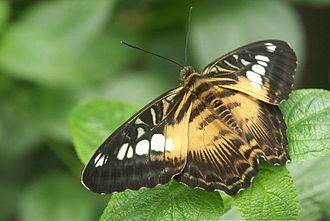Difference between revisions of "AY Honors/Insect/Lepidoptera/es"
From Pathfinder Wiki
< AY HonorsAY Honors/Insect/Lepidoptera/es
(Created page with "Species id/es | common_name = Mariposas y polillas | image = Parthenos_sylvia_philippensis.jpg | latin_name = Lepidoptera | order = '''Lepidoptera''' | description = Los lepid...") |
(Created page with "Las larvas, las orugas, tienen una cápsula para la cabeza endurecida, piezas bucales masticables y un cuerpo blando, que puede tener pelos u otras proyecciones, 3 pares de pa...") |
||
| Line 15: | Line 15: | ||
# imago/adulto | # imago/adulto | ||
| − | + | Las larvas, las orugas, tienen una cápsula para la cabeza endurecida, piezas bucales masticables y un cuerpo blando, que puede tener pelos u otras proyecciones, 3 pares de patas verdaderas y patas adicionales (hasta 5 pares). | |
Adults have two pairs of membranous wings covered, usually completely, by minute scales. In some species, wings are reduced or absent (often in the female but not the male). Antennae are prominent. In moths, males frequently have more feathery antennae than females, for detecting the female pheromones at a distance. | Adults have two pairs of membranous wings covered, usually completely, by minute scales. In some species, wings are reduced or absent (often in the female but not the male). Antennae are prominent. In moths, males frequently have more feathery antennae than females, for detecting the female pheromones at a distance. | ||
Revision as of 12:56, 18 January 2019
| Lepidoptera (Mariposas y polillas) | |
|---|---|
|
Orden: Lepidoptera
Descripción: Los lepidópteros se someten a una metamorfosis completa, pasando por un ciclo de vida de cuatro etapas:
Las larvas, las orugas, tienen una cápsula para la cabeza endurecida, piezas bucales masticables y un cuerpo blando, que puede tener pelos u otras proyecciones, 3 pares de patas verdaderas y patas adicionales (hasta 5 pares). Adults have two pairs of membranous wings covered, usually completely, by minute scales. In some species, wings are reduced or absent (often in the female but not the male). Antennae are prominent. In moths, males frequently have more feathery antennae than females, for detecting the female pheromones at a distance.
|
Lepidoptera
|

